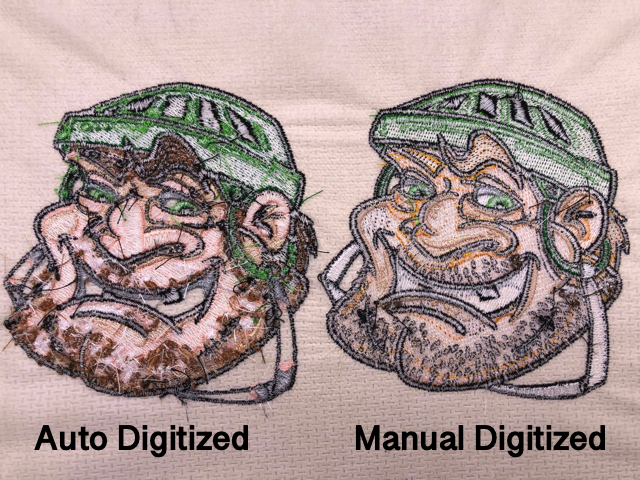Ideal Digitizing for Embroidery: Enhance Your Jobs
Grasping the Embroidery Digitizing Refine: Your Ultimate Guide
Embroidery digitizing is a thorough craft that requires precision and expertise to translate complex designs into digital formats for machine embroidery. As artisans embark on this journey to grasp the needlework digitizing process, an extensive understanding of the fundamentals sets the structure for excellence.

Recognizing Needlework Digitizing Fundamentals
Embroidery digitizing fundamentals develop the structure upon which elaborate styles are equated into machine-readable layouts for exact stitching. This initial action in the needlework digitizing process is critical for making sure that the last stitched item is a devoted representation of the original design. Recognizing needlework digitizing essentials entails comprehending crucial concepts such as stitch types, sew instructions, thickness, rug, and pull compensation.
Sew kinds play a crucial role in figuring out the visual and textural outcome of the stitched style. By choosing the appropriate stitch kind, whether it be satin, fill, or running stitch, digitizers can attain the preferred impact and enhance the general high quality of the embroidery. In addition, stitch instructions influences the circulation and measurement of the design, while thickness establishes the spacing and insurance coverage of the stitches.
Moreover, underlay sewing supplies stability to the layout by protecting the fabric and preventing distortion throughout the embroidery procedure. Pull settlement is one more vital consideration to counteract the all-natural tendency of textile to contract when sewn. Grasping these embroidery digitizing essentials is essential for creating professional-quality stitched items.
Selecting the Right Digitizing Software
Choosing the appropriate digitizing software application is a vital decision that dramatically impacts the performance and high quality of the embroidery digitizing procedure. Digitizing for Embroidery. When selecting the right digitizing software application, it is vital to think about factors such as the intricacy of styles you intend to develop, the user-friendliness of the software application, the level of consumer support provided, and the compatibility with your embroidery maker
There are numerous digitizing software program options offered in the marketplace, varying from basic programs for novices to sophisticated software application for specialist digitizers. Some preferred choices include Wilcom EmbroideryStudio, Hatch Embroidery Software Application, and PulseID. These software supply a broad variety of devices and features to aid you develop complex designs effortlessly.
Before deciding, it is recommended to explore the different software program options with complimentary tests or trials to identify which one ideal suits your requirements. In addition, reading evaluations and looking for recommendations from skilled digitizers can give valuable insights right into the strengths and weak points of each software package (Digitizing for Embroidery). By thoroughly assessing your requirements and comparing the attributes of various digitizing software, you can make an educated selection that boosts your needlework digitizing process
Digitizing Tools and Techniques

Optimizing Design Settings for Embroidery
Grasping the ins and outs of layout setups is basic in achieving optimal lead to the needlework digitizing procedure, structure upon the structure laid by understanding digitizing devices and techniques. When optimizing design settings for needlework, it is important to take into consideration factors such as stitch type, thickness, rug, pull compensation, and registration. Sew kind choice affects the overall feel and look browse around these guys of the layout, with alternatives like satin, fill, and running stitches using different structures and effects. Density describes the spacing and density of stitches, influencing the style's protection and longevity. Appropriate rug stitching offers stability and protects against textile distortion, particularly for complicated designs or on stretchy products. Draw compensation adjusts for textile stretch throughout stitching, making sure exact style duplication. Registration setups align various elements of the layout precisely, maintaining total design honesty. By fine-tuning these style settings, embroiderers can boost the quality and accuracy of their embroidered productions.

Troubleshooting Common Digitizing Issues
When running into usual digitizing concerns throughout the embroidery procedure, it is vital to comprehend the root causes and implement reliable services promptly. One usual problem is stitch density issues, where stitches might be as well thick, creating the textile to pucker, or as well sporadic, resulting in gaps in the layout. Changing the stitch density settings in the digitizing software application can assist fix this issue.
Another frequent challenge is string breaks throughout the embroidery process. This can take place due to numerous reasons such as incorrect tension setups, dull needles, or making use of low-quality string. Making sure proper maintenance of the embroidery equipment, consisting of routine needle changes and stress changes, can reduce the event of thread breaks.
In addition, style enrollment errors can cause misaligned elements within the embroidery layout. Inspecting the layout alignment in the digitizing software application and making needed changes before sewing can help in avoiding this concern. By dealing with these usual digitizing concerns promptly and successfully, you can make sure a smoother embroidery procedure and premium ended up items.
Final Thought
To conclude, mastering the embroidery digitizing procedure read this needs a strong understanding of the essentials, the ideal option of software program, and expertise of tools and methods. Maximizing design settings and troubleshooting common digitizing problems are vital action in making certain top notch embroidery outcomes. By adhering to these actions faithfully, one can attain accuracy and performance in the digitizing procedure.